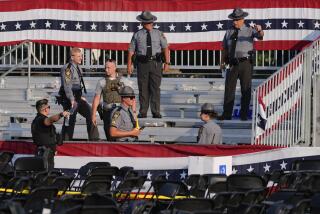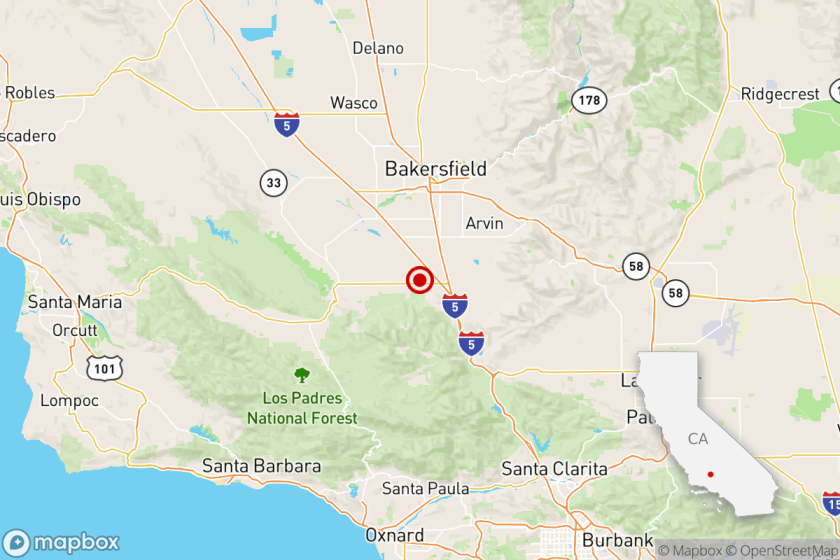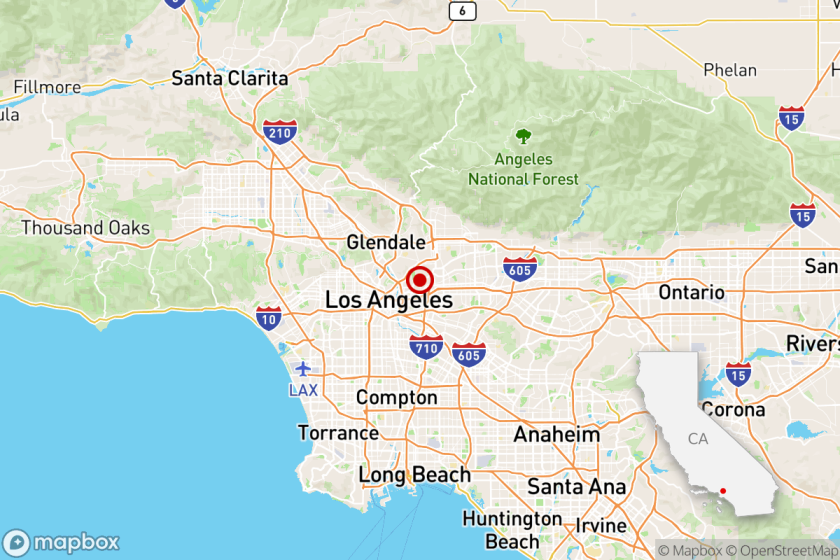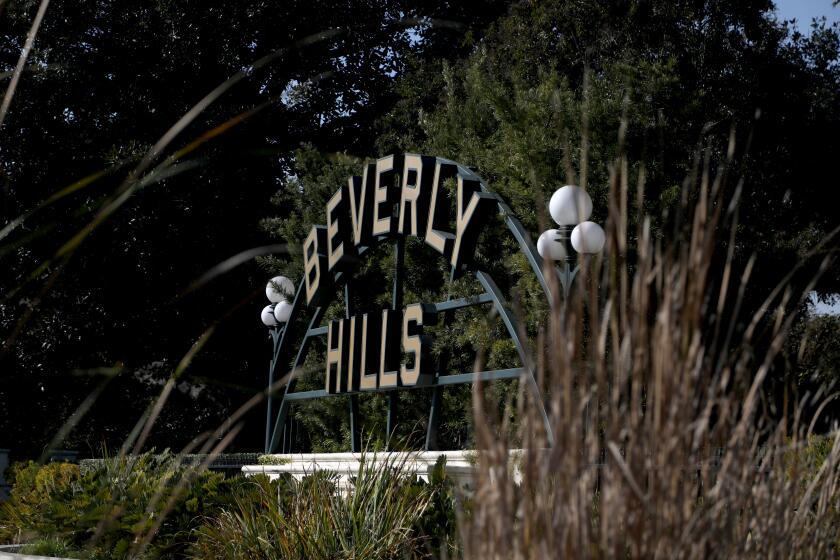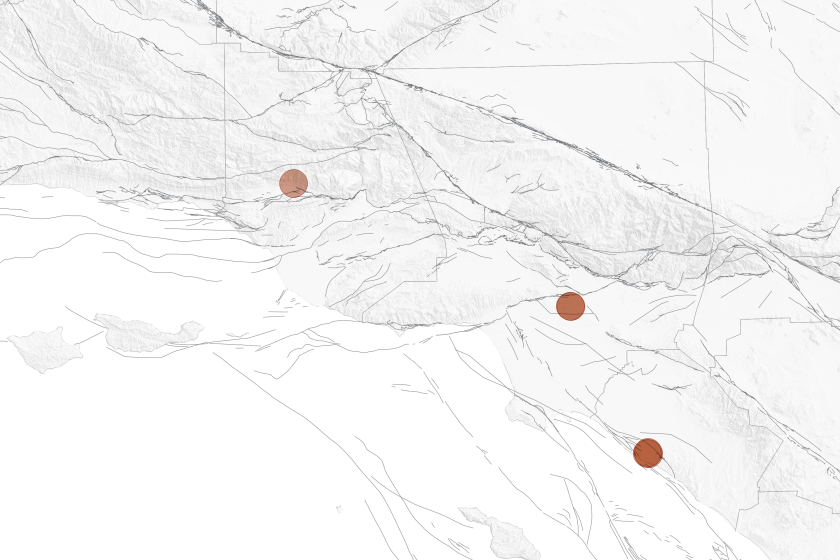Mexico City Buildings Topple as 7.8 Quake Hits Wide Area : Death Toll High; Rubble Traps Many
A violent earthquake struck Mexico City and a wide area of southern Mexico early Thursday, killing at least several hundred people, toppling dozens of buildings and trapping an untold number of the dead and injured beneath mountains of shattered concrete.
The 7:18 a.m. quake (6:18 a.m. PDT) registered 7.8 on the Richter scale, according to the U.S. Geological Survey, and was centered on Mexico’s Pacific coast, about 200 miles southwest of the capital and northwest of Acapulco. It shook much of Mexico and was felt as far away as Houston.
Remarkably, Acapulco on the coast and Guadalajara inland apparently did not sustain large-scale damage.
The initial temblor, lasting nearly a minute, was followed by at least 20 aftershocks.
Estimate of 400 Dead
The first estimate by the armed forces was that 400 had died in the capital city alone. Mexico City police spokesman Carmen Gutierrez pointed out that if the quake had struck half an hour later, as more people reached office buildings and schools, “the tragedy would have multiplied greatly.”
Some schools already were in session, and it was feared that many children would be among the casualties.
Damage was intense throughout more than 10 square miles in the center of Mexico City’s metropolitan area, the largest capital in the world with a population of nearly 18 million. Natural gas lines were ruptured throughout the stricken area, and fires raged while residents worked frantically with police, soldiers and ambulance crews to reach victims buried beneath debris.
Black smoke and dust clouds from crumpled buildings shrouded entire neighborhoods. By nightfall, as soldiers and police patrolled the streets to prevent looting, half of Mexico City was still without electricity. Local telephone service had been restored, but international lines were down.
Hotel Still Burning
Fires still burned in the ruins of the Regis Hotel on Avenida Juarez in downtown Mexico City, one of perhaps 200 buildings either demolished or damaged. The government was asking for flashlights to supplement emergency lighting so that rescue crews could work through the night.
Weakened buildings were still falling as darkness came. Numerous structures had caved in on the city’s main boulevard, Avenida de la Reforma, and in the Colonia Roma, Colonia Juarez and Colonia Doctores areas. Several structures near the national railroad station and around the Monument to the Revolution were demolished.
The Mexican government declared a state of emergency and placed the armed forces on maximum alert. Citizens were asked to stay off the streets except in emergencies. Gas was cut off in an effort to prevent more fires.
It was feared the death toll would soar as rescue workers probed the ruins of fallen buildings.
President’s Observation
Mexican President Miguel de la Madrid flew over the devastated capital and then toured the worst-hit central sector. “Unfortunately, there appear to be many dead,” De la Madrid said on Mexican television.
International communications were knocked out by a fire in the central telephone building. For hours, the only information reaching the outside was relayed by ham radio operators and by the Mexican government television station, Channel 13, which broadcast live throughout the day and could be monitored in San Diego and in Central America. Commercial radio station XEQ also remained on the air.
On Channel 13, parts of interviews were sometimes drowned out as people screamed out the names of loved ones. Men, women and children could be heard crying and wailing as they wandered through rubble-strewn streets.
Acapulco Not Hard Hit
With communications initially paralyzed, nothing was heard from Acapulco on the coast about 100 miles to the south for several hours and it was feared the famed resort had suffered a tragedy of major proportions. Finally, however, a ham radio operator reported that damage there did not appear to be extensive. Only minor damage occurred in Guadalajara, Mexico’s second largest city and the home of 30,000 Americans.
There was no way of knowing immediately how many died in the isolated towns and villages of the states of Jalisco, Guerrero and Michoacan, where the quake was fiercest. Authorities reported late Thursday that 110 to 150 people died in Jalisco and about 1,500 were injured there, mostly in the towns of Guzman and Atentique.
At Atentique, said Lt. Juan Manuel Sanchez of the Jalisco fire department headquarters in Guadalajara, part of a mountain broke off and slid down over several farmers in their houses just as they were awaking. He said that in other Jalisco towns, streets split open and people ran in panic. Many died inside their churches, he added.
Worshipers Killed
The commercial television network, Televisa, reported after it returned to the air in late afternoon that a church in the town of Guzman collapsed and killed 25 worshipers attending morning Mass. Some patients were believed buried under the rubble of the three-story Juarez Hospital in Mexico City and several buildings in the Medical Center, a large complex near downtown, collapsed.
The dust-filled air at the Medical Center was pierced by calls for help: “Bring another stretcher!”
In the capital city, a shortage of heavy equipment was hampering attempts Thursday night to free those trapped and injured beneath tons of rubble.
Airlines canceled flights into the stricken area until the airport was reopened during the afternoon. Residents of Mexico City were asked for donations of gasoline to enable rescue vehicles to remain in operation.
Looked Like Bombed City
Downtown Mexico City resembled a bombed-out Beirut. Several downtown hotels were heavily damaged or were destroyed.
On the broad and elegant Paseo de la Reforma, the two top floors of the Continental Hotel had crumpled. A few blocks away, the small Hotel Versailles was flattened, and at least 15 guests were trapped inside, bystanders said.
“Where’s Jorge?” a panicky woman asked.
“Where’s Roberto and Patricia?” someone wanted to know.
Nobody answered.
Across the street, rescue volunteers pulled bodies from a pile of concrete that once was an apartment building. Curtains and blankets were used for stretchers.
Frank Meckel, an American ham operator who lives in Guadalupe Lakes, 18 miles north of Mexico City, said the entire downtown area of the capital city was cordoned off.
At least 14 were believed dead at the 230-room Regis Hotel, where fire erupted when gas mains broke. Next to the Regis, said Meckel, the Salinas y Rocha department store was heavily damaged by fire.
Concrete Columns Snapped
On the central area’s Chapultepec Avenue, concrete columns three feet thick were snapped like matchsticks.
Another ham operator said he had seen numerous bodies in the streets, which were piled high with rubble and reported to be in utter chaos as rescuers struggled to reach trapped victims.
The moans and cries of the trapped could be heard throughout the devastated areas.
One report indicated that more than a third of the capital’s buildings were damaged.
Meckel said Mexican news agencies were reporting 200 badly damaged buildings in Mexico City itself, including the building housing Mexico’s Commerce Department, where “we understand there are people trapped.”
He said one apartment building collapsed with its concrete floors pancaked slab on slab, so that it “looked like a club sandwich.”
Huge Building Falls
In the Tlatelolco district, the 13-story Nuevo Leon Building--which was built by the government and housed about 3,600 families--tumbled down. About two-thirds of the building collapsed entirely and the rest of it was still burning late in the afternoon.
Another massive apartment building, the Multifamiliar Juarez, also collapsed,
“It was horrible,” said Ariel Rojas, 18, who was suffering from a broken pelvis and talking from a stretcher. He had been trapped with his sister and mother in a fifth floor apartment. “Between dreams, I felt the bed move. The walls cracked. I saw a flash. Then my pelvis was pinned to the floor.”
Red Cross rescuers dug him and his family out of the debris with picks and shovels.
Freelance reporter Charles Young, 26, of Madison, Wis., and Andy Daitsman, 26, of Milwaukee, told of seeing the 12-story Principiado Hotel collapse a block from the monument to the Mexican Revolution.
Daitsman said he saw workers dig about 15 people out of the rubble. “I don’t know if they were dead or alive,” he said.
Throughout the city, there were buildings eerily standing undamaged in the midst of chaos. At the Pino Suarez government law center complex, a four-story structure crashed to the ground and a 12-story building listed to one side, threatening to fall on neighboring low buildings. Another stood tall and sturdy, as though nothing had happened.
Channel 13 interviewed a young man who lost his wife under the rubble of a destroyed building, Associated Press reported.
‘I Had No Chance’
“At first I heard a tremendous noise and I grabbed my daughter and jumped out the window,” the man said, his voice choked with tears. “I had no chance to help my wife, who was killed when she was buried by the rubble.”
The man added: “The whole building was shaking. Everything was being twisted. The stove caught fire and sewage pipe popped open.
“When I jumped out the window everything came down and I was trapped in the ruins with my daughter, but we were rescued,” he said. “Under the ruins, there were the bodies of a woman and a child next to us.”
Maryann Alia and her husband, Douglas Butler, of Brentwood, who were on the first Mexicana Airlines flight arriving at Los Angeles International Airport after the Mexico City airport was reopened, said they were in their room on the fifth floor of the Hotel Galeria Plaza in Mexico City’s Zona Rosa section when the shaking began.
Escaped Down Stairwell
“We could see the tops of the buildings that had collapsed,” said Alia. As plaster began to fall around them, the couple went down a stairwell to escape. The top two floors of the building next door had collapsed. Outside, they saw a car crushed by a brick wall.
“I was scared to death,” she recalled.
Raul Antonio Arechiga, a Mexican from La Paz in Baja California, also flew in from the quake area and told of seeing the Hotel Continental and another hotel lose their top stories. People were crowding the streets and there were sirens everywhere, he said.
In Ixtapa, a resort just north of Acapulco, tourists reported that their 10-story hotel was shaken and “the damage was just massive.”
“Huge chunks of cement and glass started crashing down and people ran out into the open lobby,” Dale Zolnai, 45, a Defense Department employee, told the Associated Press on his return to Dallas with his wife P.J. “We just ran for our lives. We managed to get a taxi and get to the airport. Trees, boulders and cars littered the highway.”
“Waves were hitting the hotel,” he said. “The water is usually 80 feet away.”
U.S. Envoys Safe
U.S. State Department spokesman Bernard Kalb said in Washington that the U.S. Embassy in Mexico City was not seriously damaged and that communications were functioning. He said no American diplomats were injured.
It was announced that U.S. citizens wanting to find out about relatives in Mexico could call the State Department in Washington. The number is 1-202-632-1512.
A State Department official said the U.S. government offered disaster relief assistance immediately through the embassy in Mexico.
The Mexican Red Cross, according to Paul Stack, a member of a ham radio network called Missionary Hams, was asking the International Red Cross for anti-tetanus serum, glucose and bandages.
One Mexico City newspaper printed an extra edition with pictures of the destruction and an oversized headline that read simply, “Oh, God.”
Mexican army trucks were patrolling the streets to prevent looting. Joining the military trucks in the rubble-littered streets were bulldozers from private construction companies, which were asked to move debris and search for victims.
The city’s subway system stopped because of a power failure. Commuters traveling to work on the Metro apparently were evacuated, and there were no serious injuries reported.
The earthquake was felt as far away as southern Texas and New Mexico. In Houston, high-rise buildings swayed. Carl Sesphanow, first assistant property manager at Texas Commerce Tower, one of the tallest buildings in Houston, said, “Venetian blinds started slapping against the windows and the high-rise elevators were wobbling on their rails.”
Every tall building in Houston, he said, was shaking.
In Los Angeles, AT&T; spokesman Mike Pollack said a large number Southern California residents attempted to telephone Mexico City as soon as they heard of the quake, but all telephone communications with the 905 area, which includes Mexico City and environs, had been interrupted.
Service to other parts of Mexico that is normally routed through Mexico City was also cut off, he said. He added that AT&T; had offered to fly its emergency portable earth station to Mexico so that it could be set up in the central part of the country to restore service.
Times staff writer Dan Williams contributed to this story from Mexico City; staff writers Jack Jones, Patt Morrison and Julio Moran and photographer Boris Yaro from Los Angeles; staff writer J. Michael Kennedy from Houston and staff writer H.G. Reza from Tijuana.
More to Read
Sign up for Essential California
The most important California stories and recommendations in your inbox every morning.
You may occasionally receive promotional content from the Los Angeles Times.

